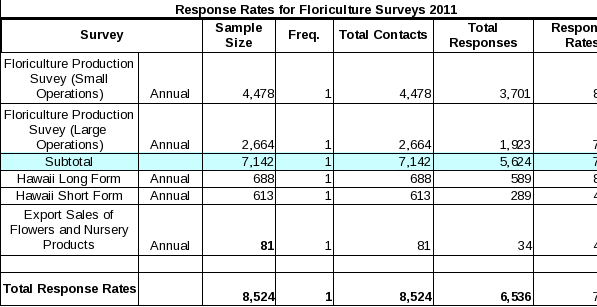0093-flor-12 - SSB
0093-flor-12 - SSB.docx
Floriculture Survey
OMB: 0535-0093
1Supporting Statement
FLORICULTURE SURVEY
OMB No. 0535-0093
B. COLLECTION OF INFORMATION EMPLOYING STATISTICAL METHODS
1. Describe (including a numerical estimate) the potential respondent universe and any sampling or other respondent selection method to be used. Data on the number of entities (e.g., establishments, State and local government units, households, or persons) in the universe covered by the collection and in the corresponding sample are to be provided in tabular form for the universe as a whole and for each of the strata in the proposed sample. Indicate expected response rates for the collection as a whole. If the collection has been conducted previously, include the actual response rate achieved during the last collection.
The Floriculture Survey is handled under the "limited coverage" survey plan. Data is now collected in the 15 major States, listed below. This reduction in the number of States surveyed was in response to budget cutbacks. In the previous OMB approval NASS was conducting these surveys in the 36 largest States, which as a group constituted about 97 percent of the U.S. value of production. Industry representatives told NASS that this reduction in States being surveyed would still provide them with the data coverage they needed, but asked that the number of States surveyed be expanded in the future, subject to funding becoming available to do so.
California North Carolina
Florida Ohio
Hawaii Oregon
Illinois Pennsylvania
Maryland South Carolina Michigan Texas
New Jersey Washington
New York
Growers in these States, and who are on NASS’s list sampling frame with annual gross sales of $10,000 or more will be included in the universe. The entire universe will receive the initial mailing with a second-request mailing to non-respondents approximately 2 weeks later and telephone and/or personal follow-ups after that. This survey typically generates a greater than 80 percent response rate.
The sample size, and response rates for each of the surveys are shown in the table below.

2. Describe the procedures for the collection of information including:
• statistical methodology for stratification and sample selection,
• estimation procedure,
• degree of accuracy needed for the purpose described in the justification,
• unusual problems requiring specialized sampling procedures
Floriculture survey questionnaires are mailed in either early December or January (mail dates are left to the discretion of each Field Office) to producers on the list frame with annual gross sales of less than $100,000. In early December Field Offices can also mail to operations that close down for the winter months (some of these operators are difficult to locate in January and February). Operations with sales greater than $100,000 are mailed to in early January. This mailing is followed by a second request mailing to non-respondents and then telephone follow-up. Large growers having complex operations are often surveyed by personal interview. Data for missing firms are estimated based on past reports or information supplied by other informed sources.
New operations that were in production the previous year, but were not contacted for the previous year’s data can be contacted the following year. Field Offices can finalize data from two years prior, while publishing preliminary data for the previous year. Data for both years can be collected at the same time from the respondent.
Individual reports are given a preliminary review by the floriculture statistician in each Field Office. State statisticians and the Headquarters floriculture commodity statistician have an Estimation Manual which provides standard analysis and estimation procedures. State survey indications and statistician recommendations are reviewed and combined to create US level results for both the previous year’s preliminary data and the final revised estimates for the year prior to that.
3. Describe methods to maximize response rates and to deal with issues of non-response. The accuracy and reliability of information collected must be shown to be adequate for intended uses. For collections based on sampling a special justification must be provided for any collection that will not yield "reliable" data that can be generalized to the universe studied.
NASS Field Offices (FO) conduct significant list building efforts for this census-type survey; all available list sources are used to build the universe lists, including information compiled from the Census of Agriculture. FO’s try to develop relationships with their State industries and large floriculture producers to encourage completion of this questionnaire. The survey enjoys significant industry support and producers respond because they are vitally interested in publication of this type of data.
Survey data are subject to non-sampling errors such as omissions and mistakes in reporting and in processing the data. While these errors cannot be measured directly, they are minimized by carefully reviewing all reported data for consistency and reasonableness.
4. Describe any tests of procedures or methods to be undertaken.
No testing of procedures or methods is done.
5. Provide the name and telephone number of individuals consulted on statistical aspects of the design and the name of the agency unit, contractor(s), or other person(s) who will actually collect and/or analyze the information for the agency.
The survey design and sample size for each State are determined by the Sampling Branch, Census and Survey Division; Branch Chief is Bill Iwig, (202)720-3895.
Data collection is carried out by NASS Field Offices; Deputy Administrator for Eastern Field Operations is Norman Bennett (202)720-3638. Deputy Administrator for Western Field Operations is Kevin Barnes (202)720-8222.
The NASS survey statistician in Headquarters for the floriculture survey is Erika White, (202)720-4215, in the Fruits, Vegetables, and Special Crops Section of the Crops Branch, Statistics Division. She is responsible for coordination of sampling, questionnaires, data collection, data processing, the Estimation Manual, and other FO support. She is also responsible for national summaries, analysis, presentation to the Agricultural Statistics Board for final estimates, and publication.
August, 2012
| File Type | application/vnd.openxmlformats-officedocument.wordprocessingml.document |
| File Title | Supporting Statement |
| Author | JACKLI |
| File Modified | 0000-00-00 |
| File Created | 2021-01-30 |
© 2025 OMB.report | Privacy Policy